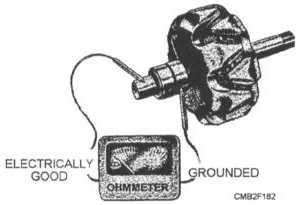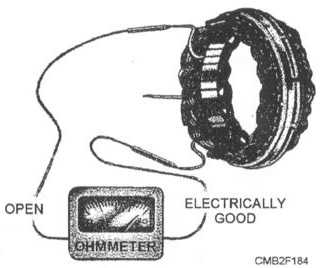Never operate an alternator on an open circuit. With no battery or electrical load in the circuit, alternators are capable of building high voltage (50 to over 110 volts) which may damage diodes and endanger anyone who touches the alternator output terminal.
Alternator maintenance is minimized by the use of prelubricated bearings and longer lasting brushes. If a problem exists in the charging circuit, check for a complete field circuit by placing a large screwdriver on the alternator rear-bearing surface. If the field circuit is complete, there will be a strong magnetic pull on the blade of the screwdriver, which indicates that the field is energized. If there is no field current, the alternator will not charge because it is excited by battery voltage.
Should you suspect troubles within the charging system after checking the wiring connections and battery, connect a voltmeter across the battery terminals. If the voltage reading, with the engine speed increased, is within the manufacturer's recommended specification, the charging system is functioning properly. Should the alternator tests fail, the alternator should be removed for repairs or replacement. Do NOT forget, you must ALWAYS disconnect the cables from the battery first.
Alternator Testing
To determine what component(s) has caused the problem, you will be required to disassemble and test the alternator.
ROTOR TESTING. - To test the rotor for grounds, shorts, and opens, perform the following:
To check for grounds, connect a test lamp or ohmmeter from one of the slip rings to the rotor shaft (fig. 2-29). A low ohmmeter reading or the lighting of the test lamp indicates that the rotor winding is grounded.

Figure 2-29. - Testing rotor for grounds.
To check the rotor for shorts and opens, connect the ohmmeter to both slip rings, as shown in figure 2-30. An ohmmeter reading below the manufacturer's specified resistance value indicates a short. A reading above the specified resistance value indicates an open. If a test lamp does not light when connected to both slip rings, the winding is open.
STATOR TESTING. - The stator winding can be tested for opens and grounds after it has been disconnected from the alternator end frame.
If the ohmmeter reading is low or the test lamp lights when connected between each pair of stator leads (fig. 2-31), the stator winding is electrically good.
A high ohmmeter reading or failure of the test lamp to light when connected from any one of the leads to

Figure 2-30. - Testing the rotor for opens and shorts.

Figure 2-31 . - Testing a stator for opens.
Continue Reading